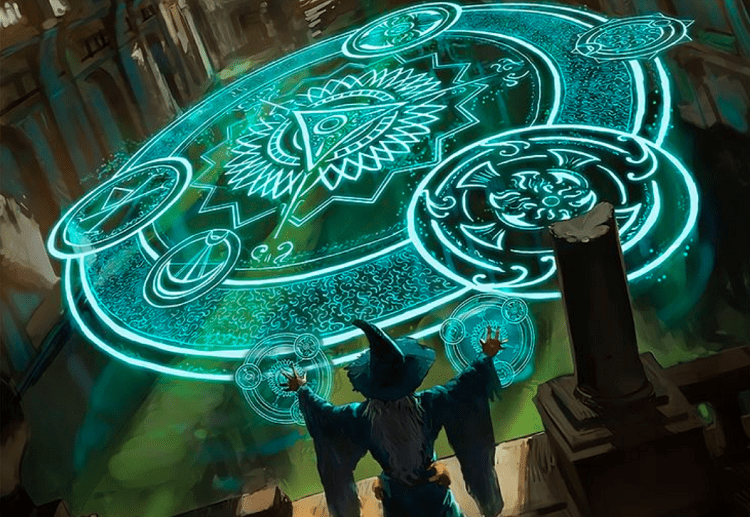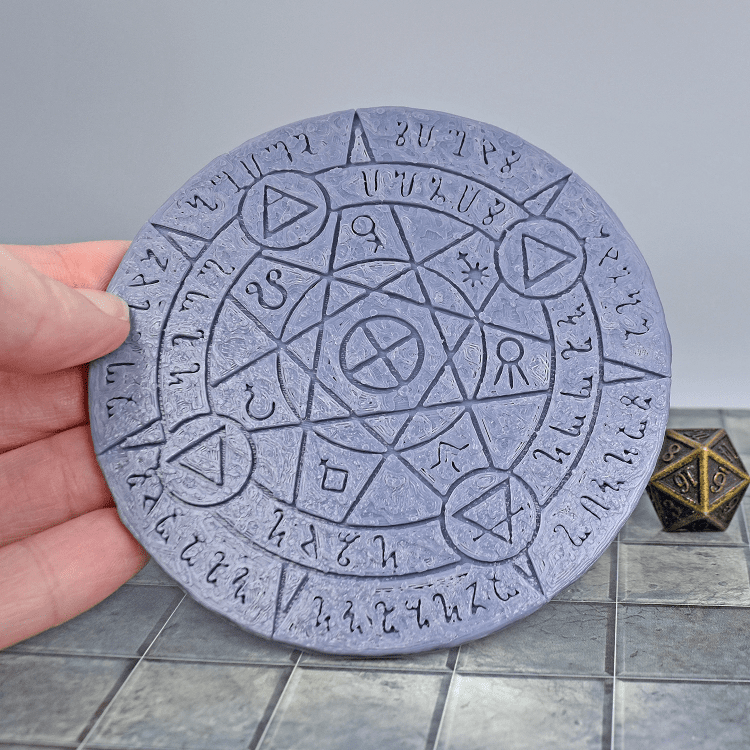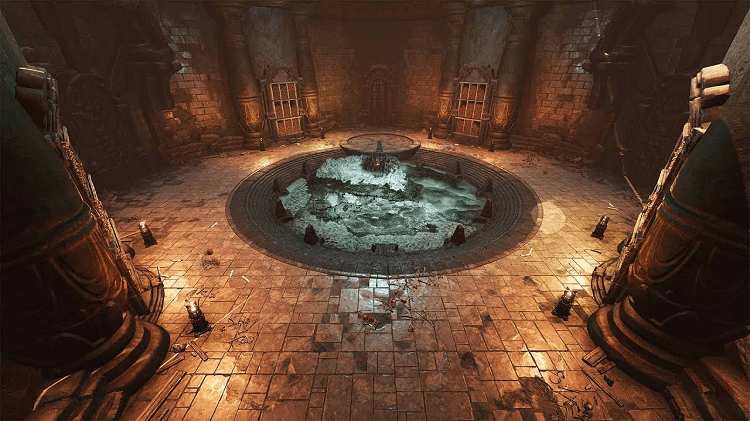Magic is a fickle thing. Depending on the series or franchise you ask for, they will explain magic differently, from runes to mana in the air, to specific systems that try to explain this supernatural thing. In this Magic Circle 5e Guide, we’re here to look at D&D’s version of magic and, more specifically, a particular D&D spell called Magic Circle.
I’m not a wizard, but close enough since I have been playing them in almost every long campaign I join or DM. Given that I have a decade of experience, I would say that I have learned this spell, especially since it was in the base Player’s Handbook. I cannot say that I know everything about it, but I think I know enough to discuss it in detail.
Magic Circle Short Version
This defensive Abjuration spell creates a 10-foot radius, 20-foot tall cylinder that wards against certain kinds of creatures. It can also work in reverse, so the spell will trap a creature instead of warding them out. It has the following functions.
- Preventing particular creatures from crossing the boundary through nonmagical means.
- To attempt teleportation or interplanar travel, it must succeed on a Charisma Saving throw
- Disadvantage on attack rolls against targets across the border.
- Targets on the other side of the boundary cannot be charmed, frightened, or possessed by the creature within the boundary.
- You can choose to make it contain or keep out
- You can choose from these creatures: Celestials, Elementals, Fey, Fiends, or Undead.
Magic Circle Long Version

This circle has many abilities and effects if it is set up in time. While some would say that the only use of this spell is to be used in conjunction with Planar Ally, I would say that it has its benefits in a defensive battle.
Here is what it can do:
| Casting Time | 1 minute |
| Range: | 10 feet |
| Target | 10 foot radius, 20 foot tall cylinder centered on a point on the ground you can see within range |
| Components | Verbal, Somatic, Material (Holy water or powdered silver and iron worth at least 100 gp, which the spell consumes) |
| Duration | 1 Hour |
It is a rare combination of a long-lasting effect and a nonconcentration spell. Meaning that once cast, this spell takes effect until dispelled or the duration passes.
Upon finishing the cast, you must choose one or more of these creature types: Celestial, Elemental, Fey, Fiends, or Undead. Once selected, you cannot change the types unless you recast Magic Circle. This spell will only affect those creature types, and here are the effects you can apply using the Magic Circle.
“Creature Cannot Willingly Enter the Cylinder by Nonmagical Means”

This is as simple as it states. For example, you can force the creature to enter by grabbing and dragging them in or through an effect that forces movement, such as a spell or a feature.
However, even if it works in reverse, the specific types of creatures designated will be unable to pass off their own volition. This means that they cannot walk, fly, or dig through it; dashing will not help, nor will the spell freedom of movement.
Essentially, it is a guaranteed roadblock or obstacle for those enemy types. Since it is guaranteed, it is one of the abilities that make this spell strong since rarely are their abilities that do not have a saving throw or chance to miss.
“If the Creature Tries to Use Teleportation or Interplanar Travel to Do so, it Must First Succeed on a Charisma Saving Throw”
Aside from regular nonmagical forms of travel, particular creatures can travel using spells. These would be Misty Step, Dimension Door, or spells like Planar Travel.
Interestingly, a creature from the outside or not listed in the registered types can still cast this spell on the creature affected by the spell. Since teleportation spells are rare, these would only be Dimension Door, Teleport, and other higher-level spells.
The Charisma saving throw is based on the caster’s spell save DC, so expect powerful Charisma-based enemies to easily break out of this spell.
Examples would be mostly Celestial type enemies and the occasional ghost-like undead. Of course, you can fix this by increasing the DC of the spell using items.
“The Creature has Disadvantage on Attack Rolls Against Targets within the Cylinder”
Keeping in mind the possibility of reversing the direction of the spell before ruling out the usefulness of this effect. Either it makes a trapped creature unable to attack accurately or creates a boundary for player characters to stay in and be protected.
Naturally, this needs to be cast beforehand due to the 1 minute casting time or ten rounds in combat, but the guaranteed disadvantage on attack rolls makes it all the better if you could set it up. This can only affect the listed types of creatures, so in specific scenarios, this spell would prove to be powerless.
Given this effect is rare, it would always be nice to have a small zone of defense, especially if you know what you are fighting in advance.
“Targets within the Cylinder can’t be Charmed, Frightened, or Possessed by the Creature”

This prevents the effects entirely, much like Bard’s class feature Countercharm. Unlike the feature, however, it also protects against possession and is constantly active within the cylinder, and it makes sure that you are unaffected by the targeted creatures.
Thematically it protects the caster from whatever they put in the circle, as a nod to how magicians summon demons within circles.
A quick warning, however, if the spell is reversed, it only protects those on the outside from the creature within, so if another creature was outside the cylinder, its effects would still be active.
“When You Cast the Spell, You Can Make the Magic Operate in the Reverse Direction”
This is the effect I talk about the most often because it turns this spell from a trap into a barrier. I would say that due to this effect alone, the other effects of the spell have enough use to call this spell necessary to learn.
Its average effect makes it something to use only in the events of Planar Ally or Summon Greater Demon since the target creature will be in an area controllable by the caster. However, with its reverse effect, you can use it to fortify a position against undead or as a way to create a temporary safe zone if you know the enemy types in the wild.
“When this Spell is Cast Using a Spell Shot of 4th Level or Higher, the Duration Increases by 1 Hour for Each Slot Level above 3rd”
Upcasting this spell allows for it to be used for a short rest or even a long rest if the caster is powerful enough. These are crucial to any multi-day campaign as getting caught off guard can be fatal to those unaware.
The only limitation left is the size of the cylinder. Still, since this spell is not a concentration spell, you can cast this multiple times, creating an overlapping area or multiple smaller circles for the party.
Usage of Magic Circle

Sad to say, but you cannot use this spell in combat. More specifically, given its one-minute casting time, taking ten rounds to cast this spell would usually end up with Magic Circle not being finished before the combat ends.
If you have the time to cast this before combat begins or need to set up a defensive area before a fight breaks out, this spell is powerful. As you can tell already, this spell is useless against enemy types not listed. (Unless the DM allows it)
However, if you manage to cast it before combat against the correct enemy types, this spell is one of the best in action. It provides many constant benefits that are always active and either trap the enemy within a confined space or protects the party.
Out of combat, you can use it in preparation for summoning spells or capturing enemies. Remember that they cannot willingly move through the cylinder’s edge, so being forced into it traps them.
Classes that Can Use it
This spell is surprisingly open to many classes; while it is a 3rd level spell, it does not stop the half-casters from gaining access to it.
Clerics
For Clerics, this spell is for protection; flavor-wise, it is to defend against fiends and fey trying to attack them. However, many usages are seen when cast in conjunction with Planar Ally. This is to enforce the summoned being to work for you.
Planar Ally does not summon a creature compelled to help but rather just one sent by the being you asked for help. Once a deal is struck, it will fulfill its end of the bargain. This spell is usually used in conjunction to ensure you can strike a deal uninfluenced.
Paladins
Like Clerics, this spell is used for defense against fiends and fey. A blackguard might use it against an angel, but this spell is generally used to protect themselves or others. While Paladins do have the capability to cast this spell, I usually see them use the slot for smiting instead or healing in general.
Warlocks
Warlocks are the inverse of Clerics but have this spell mainly to ensure their bargains with otherworldly beings go through. Kind of like a lawyer preparing their case. Of course, they can also use this spell for defensive purposes, but it seems to happen more often that they use it to speak and trade with fiends and devils.
Wizards
Wizards, the class that knows the most spells, would also have this available for them to learn. Legends say that they realize their magic from any open source, so having this to ensure that a bargain is fair makes sense.
I do not often see Wizards with this spell in tow, but whenever I do, they seem to luckily prepare it before we get into any major fights.
Is it Good?

In the right circumstances, any spell can be good. However, some spells can only work in specific circumstances or are outclassed by spells with similar effects. This is a weird case wherein it can only be used in particular circumstances but also outclasses other spells in this regard.
With the setup, this spell is fantastic against the correct enemies. It’s great out of combat, too, since it usually means that you are prepared for the circumstance rather than getting attacked out of nowhere or having to improve an encounter.
In long-lasting fights, this shines even greater as it has a one-hour duration making it 600 rounds until it dissipates.
You can improve on this spell by acquiring items that increase your spell save DC. Whether directly or indirectly through increasing your primary casting stat. Items that do this, for example, are the Rod of the Pact Keeper or Amulet of the Devout.
You could also get lucky with Tomes that increase your stat or boons. There are items that directly increase your stat points, such as Headbands of Intellect, but they usually fall short compared to a full investment of stats.
I would say that this spell is average overall but a good spell to have. If you can get information about your opponent beforehand and have time to set up, its drawbacks are nonexistent. So it depends on how well you can gather information before setting off on your adventure.
FAQs
Question: What is the Point of Magic Circle?
ANSWER: It is a defensive spell that traps a creature within a small space or protects the party from attacks.
QUESTION: WHAT DOES MAGIC CIRCLE DO?
ANSWER: Create a massive cylinder where specified targets cannot cross the boundary. Enemies will also have a disadvantage on attack rolls if they are beyond the line. It is a powerful spell for the prepared to use.
QUESTION: CAN MAGIC CIRCLE BE DISPELLED?
ANSWER: Yes, it can. Once completed and cast onto a surface, it provides a target for dispel magic. Additionally, it can get counter-spelled if the situation permits it.
Conclusion
Unlike other spells, this is not an immediate pick but rather an excellent spell to learn along the way if the possibility arises. It does not do damage but somewhat mitigates it. It is exceptional in niche scenarios and above average if its conditions can be met. It is only held back due to its casting time and lack of the ritual tag.
- Prestige Classes 5e Guide - September 20, 2022
- Rod of the Pact Keeper 5e Guide - September 15, 2022
- Sanctuary 5e Guide - September 14, 2022

